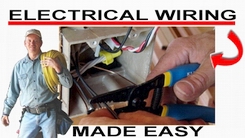» Home Energy Savings
» Need Electrical Help? Ask the Electrician
Cut Loads of Energy
 |
Summary: Energy savings tips that will lower your utility when doing the laundry. It's easy to cut your energy costs for laundry. About 80%-85% of the energy used for washing clothes is used to heat the water. © By: Dave Rongey |
Cut Loads of Energy While Doing the Laundry
You can reduce this cost by using less water by washing full loads and using cooler water and cold-water detergents - switching the temperature setting from hot to warm cuts a load's energy use in half.
If you are in the market for a new washer, look for the ENERGY STAR and read Energy Guide labels. You can reduce drying costs as well: clean the lint filter after every load to improve air circulation, and don't over-dry clothes.
Use the cool-down cycle to allow clothes to finish drying with residual heat. Also, periodically inspect your dryer vent to ensure it's not blocked.
Consider buying a natural gas dryer, the cost per load is less than an electric dryer.
Check out Laundry for more tips
LaundryAbout 90% of the energy used for washing clothes is for heating the water. There are two ways to reduce the amount of energy used for washing clothes—use less water and use cooler water. Unless you're dealing with oily stains, the warm or cold water setting on your machine will generally do a good job of cleaning your clothes. Switching your temperature setting from hot to warm can cut a load's energy use in half. |
Laundry Tips
|
The Safest Way to Test Electrical Devices and Identify Electric Wires!The Non-Contact Electrical TesterThis is a testing tool that I have had in my personal electrical tool pouch for years, and is the first test tool I grab to help identify electrical wiring. It is a Non-contact tester that I use to easily Detect Voltage in Cables, Cords, Circuit Breakers, Lighting Fixtures, Switches, Outlets and Wires. Simply insert the end of the tester into an outlet, lamp socket, or hold the end of the tester against the wire you wish to test. Very handy and easy to use.
The Quickest Way to Check for Faulty Electrical Wiring!The Plug-In Outlet TesterThis is the first tool I grab to troubleshoot a problem with outlet circuit wiring. This popular tester is also used by most inspectors to test for power and check the polarity of circuit wiring. It detects probable improper wiring conditions in standard 110-125 VAC outlets Provides 6 probable wiring conditions that are quick and easy to read for ultimate efficiency Lights indicate if wiring is correct and indicator light chart is included Tests standard 3-wire outlets UL Listed Light indicates if wiring is incorrect Very handy and easy to use.
Strip Off Wire Insulation without Nicking and Damaging the Electric Wire!The Wire Stripper and Wire CutterMy absolute favorite wire stripping tool that I have had in my personal electrical tool pouch for years, and this is the tool I use to safely strip electrical wires. This handy tool has multiple uses: The wire gauges are shown on the side of the tool so you know which slot to use for stripping insulation. The end of the tool can be used to grip and bend wire which is handy for attaching wire onto the screw terminals of switches and outlets.. The wire stripper will work on both solid and stranded wire. This tool is Very Handy and Easy to Use. |
||
Residential Electrical Parts and AccessoriesLight Switches 120volt Outlets Circuit Breakers Electrician Tools Voltage Testers |














